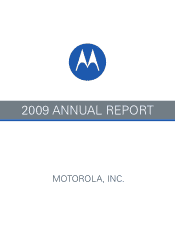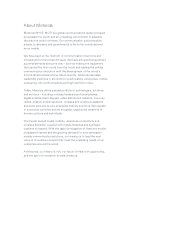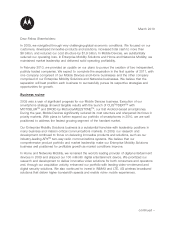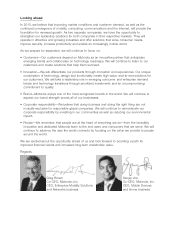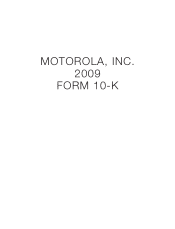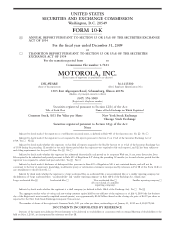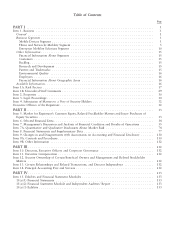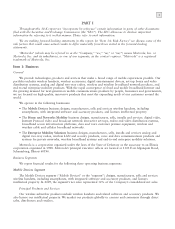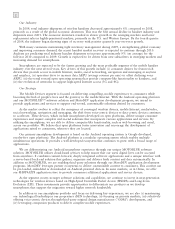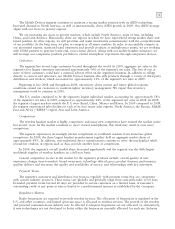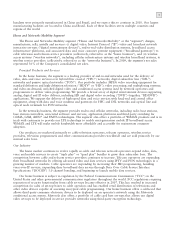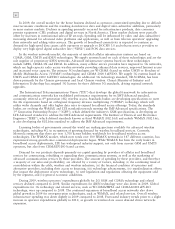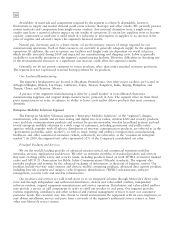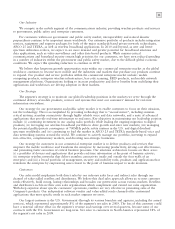Motorola 2009 Annual Report Download - page 11
Download and view the complete annual report
Please find page 11 of the 2009 Motorola annual report below. You can navigate through the pages in the report by either clicking on the pages listed below, or by using the keyword search tool below to find specific information within the annual report.
3
The Mobile Devices segment continues to maintain a strong market position with its iDEN technology.
Increased demand in North America, as well as internationally, drove iDEN growth in 2009. Our iDEN strategy
aligns with our focus on priority regions.
We are increasing our focus in priority markets, which include North America, parts of Asia, including
China, and Latin America. Historically, these are regions in which we have experienced strong market share and
brand position. In other regions, we will prioritize and make investments commensurate with the competitiveness
of our portfolio. In the long term, we plan to compete in all major markets. In order to successfully compete in
our prioritized regions, maintain brand awareness and provide products at multiple price points, we are working
with ODM partners to generate lower-end, voice-centric devices. Along with our mobile handset initiatives, we
will leverage our companion products portfolio to extend smartphone experiences through companion devices.
Customers
The segment has several large customers located throughout the world. In 2009, aggregate net sales to the
segment’s five largest customers represented approximately 54% of the segment’s net sales. The loss of one or
more of these customers could have a material adverse effect on the segment’s business. In addition to selling
directly to carriers and operators, our Mobile Devices business also sells products through a variety of third-party
distributors and retailers, which accounted for approximately 21% of the segment’s net sales in 2009.
Beginning in late 2008 and throughout 2009, uncertainty about current and future global economic
conditions caused our customers to maintain tighter inventory management. We expect this inventory
management trend to continue in 2010.
The U.S. market continued to be the segment’s largest individual market, accounting for approximately 58%
of the segment’s net sales in 2009, compared to approximately 44% of the segment’s net sales in 2008. In 2009,
the segment’s largest markets outside the U.S. were Brazil, China, Mexico and Korea. In 2009 compared to 2008,
the segment experienced sales declines in each of its four major sales regions: North America; the Europe, Middle
East and Africa (‘‘EMEA’’) region; Asia and Latin America.
Competition
The wireless handset market is highly competitive and many new competitors have entered the market in the
last several years. As the market continues to move toward smartphones, this trend may result in even more
competition.
The segment experiences increasingly intense competition in worldwide markets from numerous global
competitors. In 2009, the three largest handset manufacturers together held an aggregate market share of
approximately 69%. In addition, non-traditional device manufacturers continue to enter the marketplace while
second-tier vendors, in regions such as Asia, provide another layer of competition.
In 2009, the segment’s overall market share decreased significantly and the segment was the fifth-largest
worldwide supplier of wireless handsets on a full-year basis.
General competitive factors in the market for the segment’s products include: overall quality of user
experience; design; time-to-market; brand awareness; technology offered; price; product features; performance;
quality; delivery and warranty; the quality and availability of service; and relationships with key customers.
Payment Terms
The segment’s customers and distributors buy from us regularly with payment terms that are competitive
with current industry practices. These terms vary globally and generally range from cash-with-order to 60 days.
Extended payment terms beyond 60 days are provided to certain customers on a limited basis. A customer’s
outstanding credit at any point in time is limited to a predetermined amount as established by the Company.
Regulatory Matters
Radio frequencies are required to provide wireless services. The allocation of frequencies is regulated in the
U.S. and other countries, and limited spectrum space is allocated to wireless services. The growth of the wireless
and personal communications industry may be affected if adequate frequencies are not allocated or, alternatively,
if new technologies are not developed to better utilize the frequencies currently allocated for such use. Industry

